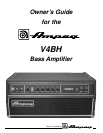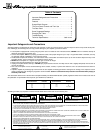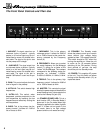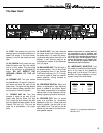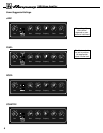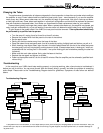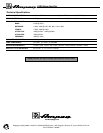
V4BH Bass Amplifier
Changing the Tubes
The performance characteristics of tubes are degraded in direct proportion to how often and under what conditions
the amplifier is used. Power tubes should be checked at least once a year - more frequently if you use the amplifier
nearly every day. When power tubes wear out, the amplifier will begin to grow weak, lack punch, fade up and down,
or lose highs and lows. Power tubes work together in a push/pull configuration and should all be replaced at the same
time with matched or balanced tubes. Your dealer can recommend the best replacement tubes for your amplifier.
Preamp tubes typically last longer than power tubes. When a preamp tube wears out, the amplifier may squeal, get
noisy, lose gain and sensitivity, or just quit working. A service center can determine which tube(s) may need replacing.
To gain access to the power tubes in the V4BH, the rear panel must be removed. Tube replacement should only
be performed by a qualified service person.
• Turn the amp off, unplug it and let it cool for at least 5 minutes.
• Remove the screws which hold the panel to the rear of the cabinet.
• Set the panel aside.
• Gently pull the tube retainer away from the base of the tube.
• Grasp the tube at its top and gently work it out of its socket by rocking it slightly back and forth as you pull on it.
• When inserting new output tubes, align the tab in the tube’s plastic base with the slot in the socket and press
the tube gently but firmly into place by pushing down on its top. (Preamp tubes have a “missing pin” which cor-
respondes with the “missing hole” in the socket – line up the missing pin and hole before pressing the tube into
its socket.)
• Make sure that each tube retainer firmly grips the base ot the tube.
• Replace the rear panel and tighten its screws.
• Power up the amplifier and let it sit for at least 20 minutes. Bias the amplifier per the schematic (qualified tech-
nicians only!).
7
In the event that your V4BH should stop working properly, or just stop working, take a few minutes to troubleshoot it
before you call for service. You can save yourself time and money doing it yourself, and often the problem is something
quite simple. Please refer to the Troubleshoointg Diagram below for guidelines. Symptoms of tube failure are defined
above.
If the problem isn’t covered above, or if the steps lead you here, then contact your Ampeg dealer for service information. Also, you
should refer your amp to an authorized service center for servicing if it gets dropped, has liquid spilled into it, or sustains damage to
its power cord.
Troubleshooting
NO SOUND
LEDs LIGHT
POOR SOUND
Check bass, cables
Check speaker(s)
Replace speaker(s)
POOR SOUND
LEDs DON'T LIGHT
Check AC outlet
NO SOUND
NO HUM HUM
Listen for hum
NO CHANGE
SOUND OK
SOUND OK
POOR SOUND SOUND OK
SOUND OK
Check amp controls, check
for signal from bass
Check power cord,
fuse, power switch
Check house fusebox
or circuit breaker
SPEAKER(S) OK,
POOR SOUND
SPEAKER(S)
DEFECTIVE
Check speaker Unplug bass,
touch tip of cable
Speaker OK
Replace cable
NO CHANGE
SEE BELOW SEE BELOW
NO POWEROUTLET OK
OK
Troubleshooting Diagram:



